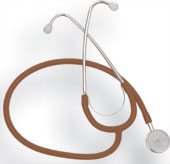 |
If you just bought a doctor’s kit for your child, you will probably need to buy the same toy again very soon. The new set will come without its best-known instrument — the stethoscope. That’s because a slew of new-age diagnostic equipment is endangering the future of the stethoscope.
The good, old stethoscope is on its way out. Physicians across the world are foretelling the demise of this curvaceous little instrument. Considered the very mascot of the healthcare profession, it might soon shift from doctors’ necks to museum shelves.
What is the biggest threat to the stethoscope? The most common competition is from trendy, hand-held doppler machines. A doppler probe will tell tomorrow’s doctor whether the patient has any major valve problems.
It will examine the patient’s pulses to detect a blocked artery. This will save precious time for the busy physician, who’s always in a hurry to get through the queue outside his chamber. In sum, it will do all that the stethoscope does without the physician having to listen hard and analyse every small chest sound. The hand-held doppler does all the listening and analysing.
Sheer necessity
Many doctors in the US have already switched to hand-held dopplers — and the nifty little gadget is slowly making its way into India.
“The stethoscope will be replaced, like any other equipment, out of sheer necessity. We can’t really afford to be nostalgic in medicine,” says Dr Kunal Sarkar, a senior cardiologist at Calcutta’s Rabindra Nath Tagore International Institute of Cardiac Sciences. Though he feels it’s a little premature yet to predict the total demise of the stethoscope, Sarkar admits that the skill of using the instrument has taken a beating among today’s physicians. Doctors don’t bother to waste time on the other subtle diagnostic signs of the heart anymore.
“Old timers used to spend half an hour listening to chest sounds of each patient because 90 per cent of their findings were based on what they heard. They didn’t have the luxury of X-rays and scans and fancy diagnostic machines. And why just the stethoscope? Most of today’s general medicine can be replaced by a Pentium-4 processor,” he exclaims.
 |
 |
 |
| Modern times: (From top) A hand-held ultrasound instrument, a portable ECG machine and an easy-to-carry doppler tool |
Doctors say the stethoscope could be a viable tool for physicians in the diagnosis of chest problems like pneumonia. But for cardiologists, the stethoscope might well be on its way out.
“Nobody bothers listening to heart sounds anymore. Even if somebody diagnoses an ‘opening snap’, a sound diagnostic of a heart condition called mitral stenosis, would he treat the disease based on this clinical diagnosis,” asks advanced laparoscopic surgeon and medical columnist Dr B. Ramana. “He would do an echocardiogram anyway. So the question is why waste time when your clinical diagnosis can be wrong? And why not order an echocardiogram straightaway? There’s nothing more accurate than an echo in diagnosing valve diseases.”
“Even if I am a very good clinician and I diagnose something clinically, I would still need to back up my diagnosis for tomorrow, in case something happens and the patient dies despite my correct diagnosis and treatment,” he argues.
Daniel M. Schinder of the Division of Cardiology at the Robert Wood Johnson Medical School in New Brunswick has studied the phenomenon of physicians’ decreased reliance on the stethoscope. He writes in The British Medical Journal, “A 21st century medical student hears inspiring lectures on cardiac auscultation, the art of diagnosing through heart sounds. This usually spurs his enthusiasm for the stethoscope. After all, it is the symbol of their chosen profession.” The students’ short-lived enthusiasm is evident during their third and fourth years, where they examine real patients with a stethoscope. “Unfortunately, soon afterwards, time becomes precious during internship and residency. It is then that they start preferring the ultrasound machine, which is much more expeditious and accurate in establishing a cardiac diagnosis. Their interest in further learning the fine points and nuances of using a stethoscope wanes,” Schinder says.
Role models for auscultation are hard to find. There are no knowledgeable mentors available to teach students the fine art. Hence, sheer practicality pushes them into ordering an ultrasound rather than spending time listening to the heart, he feels.
In the last three decades, cardiac ultrasound (or echocardiography) has emerged as a powerful diagnostic tool for patients with heart diseases. It has dramatically altered the diagnostic approach in children with congenital heart disease. “Echocardiography provides extensive information about the heart. It often clarifies stethoscopic, electrocardiographic and X-ray findings,” Sarkar says.
Both the stethoscope and the cardiac ultrasound machine might give a peek into the patient’s physical abnormalities. But the ultrasound scores as a diagnostic tool over the stethoscope at an earlier stage of a disease. For example, an ultrasound can actually measure the strength of the cardiac muscle in heart failure. The stethoscope will only provide such evidence much later when the heart actually begins to enlarge and fail.
Sound diagnosis
Similarly, an ultrasound can help identify which coronary artery caused a heart attack. It can identify causes of chest pain other than heart attacks, altering the treatment of patients and providing correct life-saving diagnosis in many cases. The stethoscope plays only a small role in pinpointing these disorders.
“Even electronic stethoscopes are being superseded by bedside echo machines. Soon we will have ultrasound machines the size of mobile phones. So, on a relative scale of importance, the stethoscope will not occupy the same haloed position any more,” Sarkar says.
There are now briefcase-sized ultrasound machines as well as smaller hand-held, book-sized portable bedside machines. They are less expensive than the standard high-end ultrasound machines and their price is expected to continue to drop.
Ultrasound transducers may become small enough to fit in a medical coat pocket just as easily as the stethoscope. Wireless transmission of the images has long been possible, further expanding portability, Schinder feels.
Stethoscope makers are also aware of the trend but decline to comment on whether sales are declining. A senior marketing executive at the India operations of the world’s largest stethoscope makers, Littman and Co, in Bangalore, says, “Yes, there is a marked difference in the way doctors look at stethoscopes today. Sales have gone up only because doctors have grown in numbers. But perhaps, relatively speaking, the demand is on the leaner side.”
However, like Sarkar, he too feels that these are still early days to write an obituary for the favourite ornament of most Indian doctors.
The steth down the years
 |
| Laennec’s tool |
Invented in 1816 by French doctor Rene Theophile Hyacinthe Laennec, the stethoscope was a simple monoaural (one-ear piece) wooden tube in the beginning. Street urchins were scratching a wooden beam with a pin. Laennec heard the sound transmitted through the length of the beam. That was his inspiration to fashion a paper tube to listen to the chests of his patients. He could link the chest sounds of the dying to the reasons for death during autopsy. Laennec then designed wooden, cylindrical stethoscopes on a lathe in his apartment.
 |
| Binaural steths |
In 1851, Arthur Leared invented a binaural (two-ear piece) stethoscope. The following year, George Cammann perfected the design of the instrument for commercial production. Cammann also authored a major treatise on diagnosis by auscultation.
 |
| Electronic steth |
Rappaport and Sprague designed a new stethoscope in the 1940s, which became the standard by which other stethoscopes are measured. The Rappaport-Sprague steth was later made by Hewlett-Packard and was considered by cardiologists to be the finest acoustic stethoscope. However, it is no longer available. Several other minor refinements were made to stethoscopes until in the early 1960s, Dr Littmann, a Harvard Medical School professor, created a new stethoscope that was lighter than the previous models.
 |
| Designer steth |
Then came electronic stethoscopes, capable of amplifying body sounds. Models like Littman, Cardionics and Welch Allyn provide a link to computers. Several electronic stethoscopes can very easily allow users to record sounds and e-mail them to colleagues for teaching or consultation. Amplification of sounds has made faint sounds much easier to discern.










